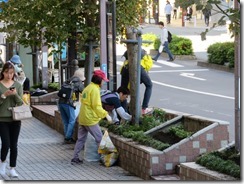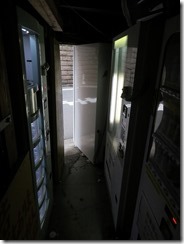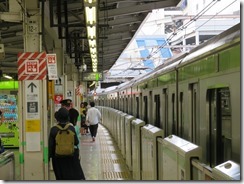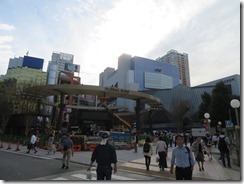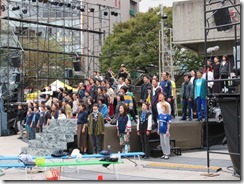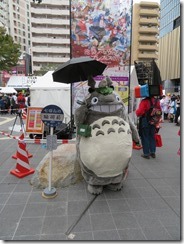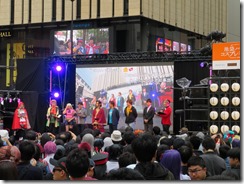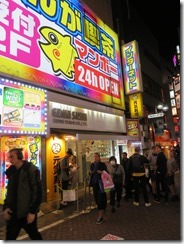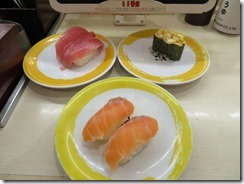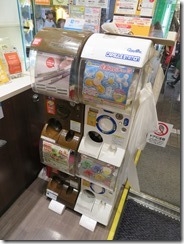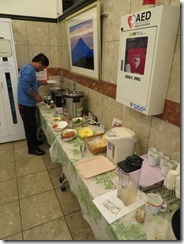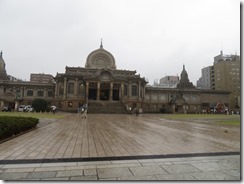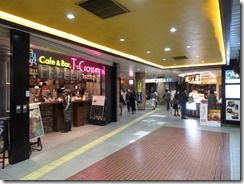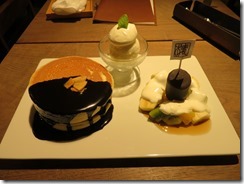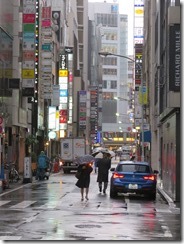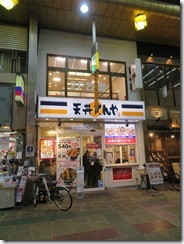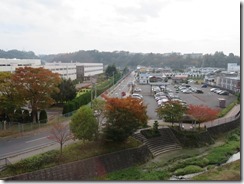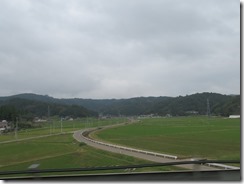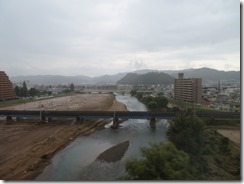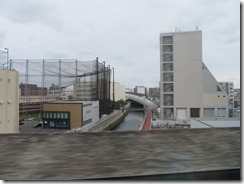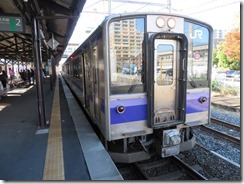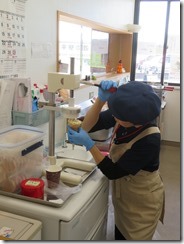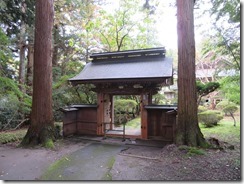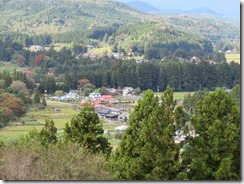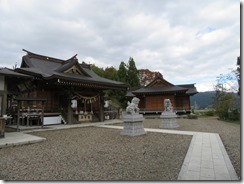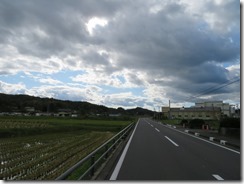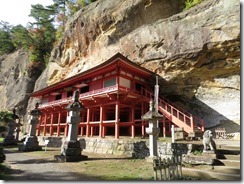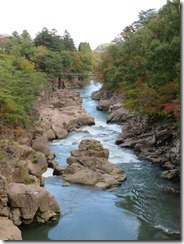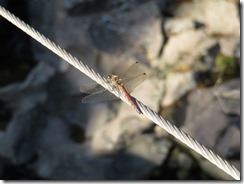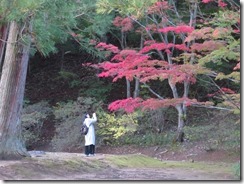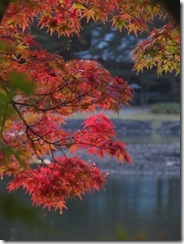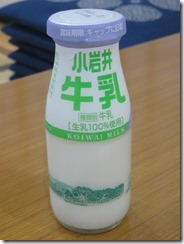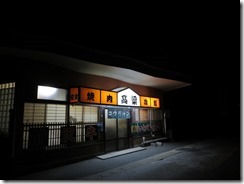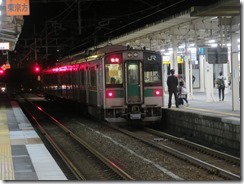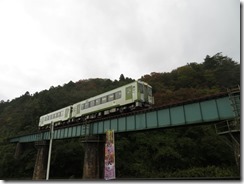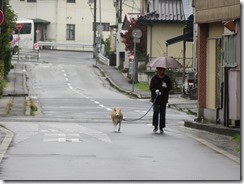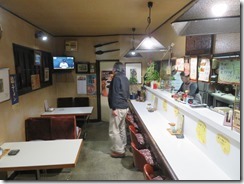Kamata is actually the location of the headquarters of Toyoko Inn. While wandering the streets yesterday looking for dinner, I happened to spot the other Toyoko Inn branch in Kamata, and noticed the signage looked kinda… old fashioned, so I wondered if maybe it was the first Toyoko Inn – it’s easy to confirm, as all Toyoko Inns are numbered in order of founding. Back at my hotel that night, I checked the Toyoko Inn hotel directory, and yep, it’s hotel number one (mine is number twenty). Kamata Station is almost precisely midway between Tokyo Station and Yokohama Station, which is why they called it Toyoko Inn.
And actually, when I took this photo, which I posted two days ago:
I was standing less than half a kilometre straight down the road from the Toyoko Inn Headquarters – I just needed to turn left instead of going straight, and I would have been there. Would I have visited had I known it was there? No idea. On the one hand, it’s just an office building, which I can see perfectly well on Google Street View. On the other hand, it’s not like I had any particular place I needed to be…
I’ve still got no idea what Toyoko Inn’s 4&5 logo is supposed to mean, though…
So, anyway, I had breakfast.
Started off the day by going up to the top floor of the hotel and seeing if I could get out onto the emergency staircase for a view. Once again a typhoon had passed, and once again it was bright and sunny. I was quite surprised to discover that the top floor had rooms on only one side, and the hallway was actually a balcony, open to the air. Couldn’t get out onto the emergency stairs, though there was a nice view towards the station from the front of the building. Couldn’t get out on the two floors below either. So I wound up just going back to my floor – the sixth floor – where I’d tested the door previously and found it open.
Then I decided to take a roundabout walk to the train station, along the nearby Nomi River. As I passed Kamata Elementary School, they appeared to be hosting their annual Sports Day (i.e. what we’d call an athletics carnival in Australia)… but it’s Saturday. Also saw a volunteer force doing garden work by the side of the road.
Today’s plan was big city sightseeing and souvenir buying – complete my once-per-trip pilgrimage to Akihabara, visit a couple other of the big centres around the Yamanote line, that sort of thing. So I hopped on the Keihin-Tohoku train, and hopped off at Akihabara Station. Fairly sure this is my first time arriving at Akihabara on the second-level north-south platforms since 2010 – on my last two visits, I (and we) arrived on the east-west Chuo-Sobu line platforms on the fourth level, and it was… weirdly different being on the lower level. I went for a quick wander, got lost, took an exit I found that lead directly from the station into the Atre shopping centre, got even more lost, and eventually found myself standing on the street opposite the Labi building, the one with the escalators on the building facade which I’d photographed every visit, but have thus far never entered.
So I entered. It was all shiny inside, filled with all manner of computers and computer peripherals – including half a floor of USB hard drives, which would have been nice to have in Ichinoseki when I was looking for one. I rode the escalators all the way to the top, browsing just enough en route to make it look to the shop assistants like I wasn’t just there to ride the escalators to the top, then rode the lift back down to street level. (Oddly, at the top floor of the shop, there was a closed-off staircase where the escalator should have been, and it was… rather decrepit and decayed looking. You’d have thought they’d either maintain it or hide it out of sight.)
I popped into a few shops trying to find the figurine I’d been trying to find on my last visit (though, I said at the time that I realised it wouldn’t come out until October, but closer inspection of the listing on the website today revealed that it had actually come out this October). I was finally able to find it in the third shop I entered (actually, the very same shop that pointed out I was looking too early last visit)… only to discover that it cost 100,000 yen, or about twice the posted price on the manufacturer’s website. Guess it’s in pretty high demand. I did find the figurine of another character from the same series, but she’s not really my favourite, so instead I made an impulse buy of a different character from a different series… honestly not entirely sure why.
I had a go at couple of crane game machines – because so far, I never had – but then I decided to pop into the Gachapon shop and see if I could find any machines with prizes I was interested in. I found one with Spider-Man (and also Night Monkey and Mysterio as other possibilities, though I got Spider-Man), and one which was completely blind lucky dip, but it cost only 200 yen (the rest were 300-500) so I went for it… and got a rubber keychain thing. Honestly, not too sure what I was expecting, considering that rubber keyring things or badges seem to be quite common.
I’d planned to meet someone for lunch in Ikebukuro, who’s a member of the online forum of the website where I study kanji, but I still had about half an hour until I needed to go, so I thought I’d drop by one more place: a location colloquially dubbed the “Akihabara Creepy Vending Machine Corner”. On the ground floor of a slightly decaying corrugated-iron-clad building on the corner of a street just south of the Kanda River is an open space, which is entirely crammed full of a haphazard collection of vending machines. Some of them normal – drinks, nuts, popcorn – some odd – plastic beetles, Himalayan rock salt, tinned bear meat, cannisters full of bells, or train tickets from the Showa era – and some downright mystifying – whole machines filled with mystery boxes wrapped in white paper, with odd… um… stories on the front (in Japanese). Like, I don’t get what’s going on here. Who put these machines here? Who stocks these machines?
I walked within a block of this place back in 2017 – at one point, I crossed a bridge and turned left, but if I’d turned right, I would have seen it, and so somehow I completely missed it. I decided to buy one of the mystery boxes, for the fun of it – the story on mine starts “I went to my friend Tanaka-kun’s house for insurance sales, and his mother received me, and I was able to give lots of information about insurance.” It continues from there with the mother… uh… asking for more information on insurance, wink wink, so I don’t think I’ll continue translating. There was a second story hidden on the bottom of the box, which I’ve not started attempting to read yet. The actual contents of the package was Choco Bats – basically, those sponge finger biscuits covered in a layer of chocolate (so they look kinda like baseball bats, I guess), though I confess I’m not entirely sure they cost what I paid for it. Good for an occasional snack, though.
(Just watched a video on YouTube (opens in a new window) where they buy ten boxes and open them all to see what’s in them. All snack foods – crackers, animal crackers, occasionally Kit Kats. Also, in the same vlogger’s earlier video filmed here, she found tinned bread in one of the machines, which I really wish I’d seen, because I’d like to try it. Next time, I guess…)
Headed from there to a fun t-shirt shop I’d visited on prior stops in Akihabara, at which point I suddenly realised it was already very nearly time for me to be in Ikebukuro, so I scrambled off to catch the Yamanote line train, and by the time I’d boarded and found a seat, it was already the time we were supposed to meet. What happened to all the extra time I had?
I hurried to our planned meeting spot – the lobby of the Tokyo Metropolitan Theatre – a mere half-hour late, taking the wrong exit from Ikebukuro Station as I did so. As I stood in the lobby trying to spot my friend, fortunately he spotted me – I made a point of wearing my red jumper today, and I’d sent him a photo of what I look like in it the night before. We were meeting here for lunch, and a restaurant specialising in rice balls – I had one with negi-miso, and one with salmon-mayo. Very yum.
Then we headed out for him to show me some of the local sites – first, there was a woman painting a picture in front of a seated audience on the floor below the theatre lobby, and outside was a choir singing (not at all what for).
But more to the point, today was Ikeharo – the Ikebukuro Halloween party (“haro” being short for “harowin” = Halloween). Japan’s really taken to Halloween (having imported it from America) mostly because it’s an excuse to get dressed up and eat lots of sugar. But mostly the dressing up – Japan really knows how to do costumes. But because Halloween itself is on a school night more often than not, it hosts the main celebrations the weekend previous. Which is this weekend.
Point is, Ikebukuro is hosting a big cosplay (short for “costume play” = dressing up in costumes, often of characters from anime or games or manga, though not always) party today. So we headed over to the other side of the railway lines via a pedestrian underpass, which is in the middle of having its walls painted in a lovely pastel pattern (and passing en route the exit to the station I’d taken way back on day 1, except today I completely failed to recognise it in the slightest).
Our first destination was Naka-Ikebukuro Park, in the shadow of the Ikebukuro Animate Building (“Animate” being the name of the company which is Japan’s largest retailer of anime, games and manga, rather than a verb) where the Ikeharo Main Stage was located, featuring costume judging and corporate booths and a face-painting tent and so forth. I wandered around there for a bit taking photos of cosplayers. It’s polite to ask them first before photographing, so that they can display for your photo how they want to appear – striking a pose, not picking their noses, that sort of thing – but I found it difficult to approach people in the crowd, especially with everyone watching the stage, so I only took a couple of photos.
When I arrived, though, I noticed a girl on the stage dressed as Elizabeth, a character from a manga and anime named The Seven Deadly Sins (the one in pink) – I discovered after returning to Australia, that the girl is Enako, known as Japan’s number one cosplayer, who earns more than a million yen per month from her cosplay. My little… not-quite brush with fame. And also, a guy holding a rabbit.
We extricated ourselves from there, and headed for the next location marked on the event map, South Ikebukuro Park, but… nothing seemed to be happening there. I guess perhaps everyone was just at the main stage? We headed from there back towards the station, spotting on the way this ridiculous bus. I’m not sure it’s quite got enough wheels.
Back near the station, my host graciously shouted me a hot chocolate from Starbucks so we could sit and chat for a bit, but soon he had to head home to watch England play in the rugby semi-finals. He pointed me towards his favourite bookshop on the way, so I popped in there to see if I could find a few books I’d been looking for but thus far hadn’t found – and was completely successful. (Also saw a movie poster for “Sora no Aosa wo Shiru Hito yo” aka “To Those Who Know of the Blueness of the Sky” aka “Her Blue Sky”, the film I mentioned a while ago by the writer of Anohana and Kokosake, and discovered that it’s already out in cinemas in Japan – actually, it was released the day I arrived. Sorely tempted to go see it.)
With the sun setting, I decided to return to the station and head for my next destination, Shibuya. Except I’d hoped to visit the Kinokuniya Main Store which I’d thought was in Shibuya, but as we pulled into Shinjuku Station, I suddenly realised that I’d mixed up Shinjuku and Shibuya again. In a sudden impulse decision, I scrambled off the train and went to visit Kinokuniya anyway. It was… fairly large, but it was nine storeys tall, rather than one floor the size of an airplane hanger (mmm, hyperbole) as is rather typical for Japan, I guess, so it was a little tricky to get the true scale of it. There were uniformed elevator attendants, which I’ve not seen in a long while.
Back on the train, I soon arrived at Shibuya for real. For in Shibuya there was to be another Halloween party – the Shibuya Pride Shibuya Halloween party. Several roads are closed to traffic, and people walk all around them in costume. And please note the “Pride” part doesn’t mean it’s a gay pride parade, but rather that they’re trying to insert an element of “let’s take pride in how lovely Shibuya is” – last year’s party got a bit rowdy, and a truck was overturned, among other things, so this year alcohol on the street is banned.
First thing’s first, though: I headed up to the top of the Magnet building, just to the right of the station, where I’d heard there was an observation deck overlooking the Shibuya Scramble. It costs 300 yen to enter (as a crowd management measure), but it’s a pretty good view over the Scramble. You can also pay extra for selfies taken by a camera further up on the building, which are magically sent to your phone.
Then I went to have an early dinner before the event started. And because I hadn’t had sushi yet this trip, I headed for Genki Sushi, a sort-of sushi train restaurant chain where you order what you want off an iPad, and it comes out to you fresh right to your seat by the train. Or, I guess maybe it’s a sushi monorail? Though, after placing my first order, I was sitting already with the camera to take a photo of the food coming out, and I happened to glance behind me, and saw a waitress coming out with the food in her hands – I must have looked disappointed, because she faltered, turned around, and disappeared back into the kitchen with the food, which soon came out on the train. I’m… really not sure why she was bringing it by hand.
It was… well, it tasted like sushi. But yeah, the place is a gimmick rather than a Michelin-starred restaurant. I had some regular stuff – tuna and salmon nigiri, corn genkan, inarizushi, some burdock root rolls – then decided to try the hamburg sushi, tiny hamburger patties on rice. Finished off with some apple jelly. And over dinner, my external phone battery ran flat, for the first time on this trip. The horror! Had to change to my backup (the one that had been my primary before I bought this battery here in Japan in 2018). Actually, I noticed the phone had been running quite hot today, which is not very conducive to charge speed or battery capacity.
Lots of foreigners in the place – I had to help my neighbour read the cocktail menu, which wasn’t in English for some reason. I found a gachapon machine by the registers with tiny trains in it – I got a model of the E231, which is the same model of train as the simulator I’d been trained on way back at the Railway Museum in Omiya – then left to find a much longer queue waiting than when I’d gone in.
By which point, the Shibuya party was kicking off in earnest, except… it was really just a huge crowd filing past each other up and down the street, where a few of them happened to be in costume. Saw a few people in costumes that I’d seen back at Ikebukuro, though.
A page I found on Google suggested that costumed people might be more approachable if I were also in costume, and suggested that Don Quixote (a Japanese discount store chain known colloquially as Donki, since “Don Quixote” in Japanese is “Don Kihōte”) would be a good place to buy one – and there was one right there, so I popped inside to maybe buy some devil horns to go with the red jacket I was already wearing… and found it packed full of people doing the same thing.
One fun little thing about the party, though, was the local Burger King getting in on the act turning itself into a world-first Ghost Store, filled with zombies, and selling only Ghost Whoppers (basically, whoppers with a white bun). I didn’t actually go inside, though.
I was a little bit over the crowd, so I decided to head back towards the station. When I got there, I decided to walk around behind the station building to see if the new Shibuya Scramble Square building was open – it’s got an observation deck on the roof too, but a much grander deck and a much higher roof. It would be having its grand opening on November 1st, but I thought just maybe it’d be open for business prior to the grand opening – I’d seen a press tour of the place on the news, and they’d sure looked open for business – but no.
Once I was there, though, I spotted a side overpass that intrigued me, so I wandered in that direction… and found myself in a new shopping centre built in the former Tokyu Toyoko line Shibuya Station (and yeah, that Toyoko is the same name as Toyoko Inn – Tokyo plus Yokohama). A video did the rounds of the internet a few years ago of engineers converting a surface train station into a subway station in a single night in 2013 – you may have seen it, but here it is if you didn’t (that’ll open in a new window; turn the subtitles on for English) – that was this station. (Well, actually, it was Daikanyama Station, the next one in line, but you get the point.) By connecting the Toyoko Line to Tokyo Metro’s comparatively-new and completely underground Fukutoshin Line, it also allowed traffic from Tobu, Seibu, Tokyu, the Tokyo Metro and the Yokohama Minatomirai Railway to cross the entire city without stopping. Plus, it allowed them to demolish the raised Toyoko line Shibuya Station and connecting tracks. And I dunno why, but I kinda like this track-sharing between companies – it makes me feel warm and fuzzy. (Actually, one of my trains during the Underground Mysteries game yesterday was a Tokyu train, which had started on the Tobu Skytree line, was currently on the Metro Hanzomon line, and would be finishing on the Tokyu Den-en-toshi line. But I digress.)
The former station platforms had now become a new shopping centre named Shibuya Stream… and that name reminded me of a place I’d wanted to see near here – the Shibuya River. The river has always run through this valley, but in modern-day Shibuya, it had become a bit hemmed in by buildings and concrete, and a but neglected. But it turned out the Toyoko line tracks used to run alongside the river, and they’d now been turned into a very nice linear park, lined by lanterns with paper shades designed by kids. So I strolled gently along the park until I hit another new shopping centre named Shibuya Bridge, located where the former tracks turned away from the river heading for the next station, so at that point I decided to turn back to Shibuya Station. And even though I left the party early for an early night, I wound up leaving Shibuya quite late after all.
Back at the station, I decided to see why there were signs pointing the way to the JR Station up the escalator (even though the station entrance should have been at ground level) and encountered an entrance to the Metro station which I’m certain I took back in 2017… except at the time, it was just a dark staircase in the middle of a construction site. I mean, it’s possible it was a different entrance – I had been pretty lost at the time – but it’s an amazing change in just a couple of years.
Changing at Shinagawa Station to the Keihin-Tohoku Line for my hotel, I decided to buy a bottle of iyokan drink (it’s a Japanese citrus fruit) which mentioned “1% fruit juice” on the label, and… I’m pretty sure it was 1% fruit juice and 99% water. A homeopath’s idea of fruit cordial. Water that had once been in the same room as an iyokan. One star, do not recommend. Bleh.
Back at Kamata, I happened to come across a roast sweet potato truck just outside the back door of my hotel. I kinda regretted not getting a roast potato from the truck I’d seen in Kyoto back in 2017, so I went to go see if I could buy one now… except he’d just finished for the night, and was only packing up. Very sad face.
Plus, it suddenly occurred to me that I’d clean forgotten to visit the third – and largest – event location for Ikeharo: the Sunshine Plaza. Whoops.
Welp, here’s my little toy collection from today, in any case:
Today’s photo count: six hundred and fourteen.
Today’s pedometer count: 22,695 steps – 16.6 kilometres – 19 flights of stairs.







